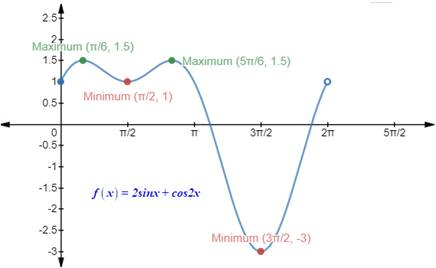
Concept explainers
(a)
To find : the maximum and minimum point of the function
(a)
Answer to Problem 82E
The maximum points of the function are
The minimum point of the function are
Explanation of Solution
Given information : Function
Concept Involved:
A maximum is a high point and a minimum is a low point over the given interval.
Graph:

Interpretation:
The graph of the function
(b)
To find : all the solutions of the trigonometric equations in the given interval
(b)
Answer to Problem 82E
The solution to the given trigonometric equation are
Explanation of Solution
Given information : Function
Concept Involved:
Solution to a
To solve a trigonometric equation, use standard algebraic techniques (when possible) such as collecting like terms, extracting square roots, and factoring.
Our preliminary goal in solving a trigonometric equation is to isolate the trigonometric function on one side of the equation.
Calculation:
Factor the Greatest Common Factor from left side of the equation
Using the zero factor property which states that if
Solving the 1st equation and finding x values that makes it true in the interval
- By dividing 2 on both sides
- By simplifying fraction on both sides of the equation
Solving the 2nd equation and finding x values that makes it true in the interval
- By subtracting1 on both sides of the equation
- By simplifying on both sides of the equation
- By dividing -2 on both sides of the equation
- By simplifying fraction on both sides of the equation
Conclusion:
Chapter 5 Solutions
EBK PRECALCULUS W/LIMITS
- For the system consisting of the lines: and 71 = (-8,5,6) + t(4, −5,3) 72 = (0, −24,9) + u(−1, 6, −3) a) State whether the two lines are parallel or not and justify your answer. b) Find the point of intersection, if possible, and classify the system based on the number of points of intersection and how the lines are related. Show a complete solution process.arrow_forward3. [-/2 Points] DETAILS MY NOTES SESSCALCET2 7.4.013. Find the exact length of the curve. y = In(sec x), 0 ≤ x ≤ π/4arrow_forwardH.w WI M Wz A Sindax Sind dy max Утах at 0.75m from A w=6KN/M L=2 W2=9 KN/m P= 10 KN B Make the solution handwritten and not artificial intelligence because I will give a bad rating if you solve it with artificial intelligencearrow_forward
- Solve by DrWz WI P L B dy Sind Ⓡ de max ⑦Ymax dx Solve by Dr ③Yat 0.75m from A w=6KN/M L=2 W2=9 kN/m P= 10 KN Solve By Drarrow_forwardHow to find the radius of convergence for the series in the image below? I'm stuck on how to isolate the x in the interval of convergence.arrow_forwardDetermine the exact signed area between the curve g(x): x-axis on the interval [0,1]. = tan2/5 secx dx andarrow_forward
 Calculus: Early TranscendentalsCalculusISBN:9781285741550Author:James StewartPublisher:Cengage Learning
Calculus: Early TranscendentalsCalculusISBN:9781285741550Author:James StewartPublisher:Cengage Learning Thomas' Calculus (14th Edition)CalculusISBN:9780134438986Author:Joel R. Hass, Christopher E. Heil, Maurice D. WeirPublisher:PEARSON
Thomas' Calculus (14th Edition)CalculusISBN:9780134438986Author:Joel R. Hass, Christopher E. Heil, Maurice D. WeirPublisher:PEARSON Calculus: Early Transcendentals (3rd Edition)CalculusISBN:9780134763644Author:William L. Briggs, Lyle Cochran, Bernard Gillett, Eric SchulzPublisher:PEARSON
Calculus: Early Transcendentals (3rd Edition)CalculusISBN:9780134763644Author:William L. Briggs, Lyle Cochran, Bernard Gillett, Eric SchulzPublisher:PEARSON Calculus: Early TranscendentalsCalculusISBN:9781319050740Author:Jon Rogawski, Colin Adams, Robert FranzosaPublisher:W. H. Freeman
Calculus: Early TranscendentalsCalculusISBN:9781319050740Author:Jon Rogawski, Colin Adams, Robert FranzosaPublisher:W. H. Freeman
 Calculus: Early Transcendental FunctionsCalculusISBN:9781337552516Author:Ron Larson, Bruce H. EdwardsPublisher:Cengage Learning
Calculus: Early Transcendental FunctionsCalculusISBN:9781337552516Author:Ron Larson, Bruce H. EdwardsPublisher:Cengage Learning





